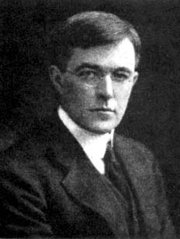Irving Langmuir
|
|
Irving Langmuir (January 31, 1881 in Brooklyn, New York - August 16, 1957 in Woods Hole, Massachusetts) was an American chemist and physicist. While at G.E., from 1909-1950, Langmuir advanced several basic fields of physics and chemistry, invented the gas filled incandescent lamp, the hydrogen welding technique, and was awarded the 1932 Nobel Prize for Chemistry for his work in surface chemistry.
Early years
Irving Langmuir was born in Brooklyn, New York on January 31, 1881. He was the third child (out of four) of Charles Langmuir and Sadie, née Comings. During his childhood, Langmuir's parents actively encouraged him to carefully observe nature and to keep a detailed record of his various observations. When Irving was eleven, it was discovered that he had rather poor eyesight. When this problem was corrected, details and observations that had previously eluded him were revealed. Because of this, his interest in nature and the various complications of nature was heightened.
During his childhood, Langmuir was greatly influenced by his older brother Arthur Langmuir. Arthur was a research chemist who also encouraged Irving to be curious about nature and how things work. Arthur helped Irving set up his first chemistry lab in the corner of his bedroom and he was always there to answer the myriad of questions that Irving would pose to him (which most of the time were on rather trivial matters).
He attended his early education at various schools and institutes in the US and in Paris (1892-1895).
He graduated with a B.S. from the Columbia University School of Mines in 1903 and did postgraduate work in chemistry under Nobel laureate Walther Nernst in Göttingen and earned his Ph.D. degree in 1906. Langmuir then taught at Stevens Institute of Technology in Hoboken, New Jersey, until 1909, when he began working at the General Electric research laboratory (Schenectady, New York).
Langmuir married Marion Mersereau in 1912. They had a son, Kenneth, and a daughter, Barbara.
His initial contributions to science came from his study of light bulbs (which was a continuation of his Ph.D. work). First his improvement of vacuum techniques led to the invention of the high-vacuum tube. A year later he and colleague Lewi Tonks discovered that the lifetime of a tungsten filament was greatly lengthened by filling the bulb with an inert gas, such as argon, which is an important part of the modern day incandescent light bulb.
As he continued to study filaments in vacuum and different gas environments he began to study the emission of charged particles from hot filaments (thermionic emission). He was one of the first scientists to work with plasmas and was the first to call these ionized gases by that name.
He introduced the concept of electron temperature and in 1924 invented the diagnostic method for measuring both temperature and density with an electrostatic probe, now called a Langmuir probe and commonly used in plasma physics. The current of a biased probe tip is measured as a function of bias voltage to determine the local plasma temperature and density.
He also discovered atomic hydrogen, which he put to use by inventing the atomic hydrogen welding process.
Later years
Langmuirtime.jpeg
Following World War I Langmuir contributed to atomic theory and the understanding of atomic structure by defining the modern concept of valence shells and isotopes.
He joined Katherine Blodgett to study thin films and surface adsorption. They introduced the concept of a monolayer (a layer of material one molecule thick) and the two dimensional physics which describes such a surface. In 1932 he received the Nobel Prize for Chemistry "for his discoveries and investigations in surface chemistry."
In 1938, Langmuir refuted the claim of entomologist Charles H. T. Townsend that the deer botfly flew at speeds in excess of 800 miles per hour. Langmuir estimated the fly's true speed at 25 miles per hour.
During World War II Langmuir worked to develop protective smoke screens and methods for de-icing aircraft wings. This research led him to discover that the introduction of dry ice and iodide into a sufficiently moist cloud of low temperature could induce precipitation (cloud seeding), allowing some degree of weather control.
In 1953 Langmuir presented a colloquium on Pathological science.
External links and references
- "Langmuir, Irving (http://www.infoplease.com/ipa/A0767167.html)" Infoplease.com.
- " Irving Langmuir's Ball Lightning Tube (http://www.amasci.com/freenrg/balllg1.html)". Ball Lightning Page. Science Hobbyist (http://www.amasci.com/).
- William David Coolidge, Irving Langmuir, Joseph John Thomson (http://www.aip.org/history/esva/catalog/esva/Coolidge_David.html) (Photo (http://store.aip.org/OA_MEDIA/esva/langmuir_c4.jpg) (JPG)) [aip.org].
- "Irving Langmuir (http://www.harvardsquarelibrary.org/unitarians/images/WHITNEY6.JPG) shows Whitney one of his inventions, the Pliotron tube. ca. 1920.". Willis Rodney whitney (http://www.harvardsquarelibrary.org/unitarians/whitney.html): the "Father of basic research in industry".
- "Pathological Science" (http://www.cs.princeton.edu/~ken/Langmuir/langmuir.htm) - "famous" lecture of 1953 December 18 at GE Labsde:Irving Langmuir
es:Irving Langmuir fr:Irving Langmuir nl:Irving Langmuir ja:アーヴィング・ラングミュア

